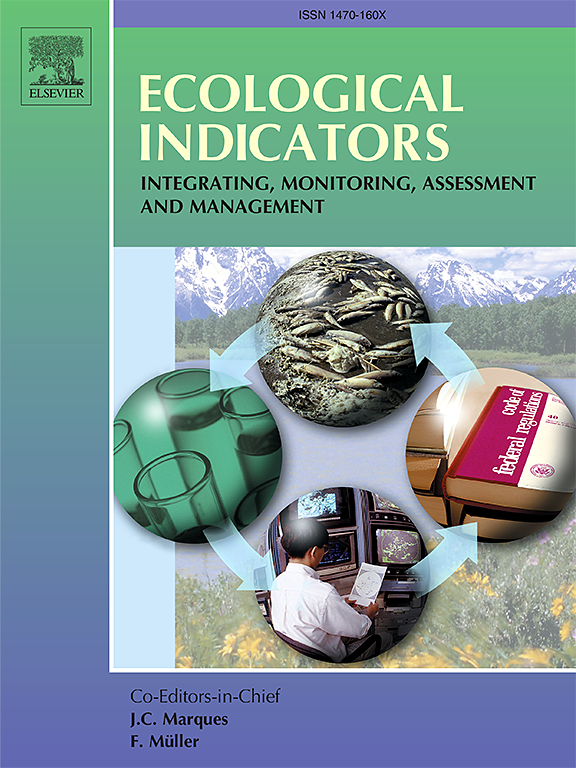京津冀地区水资源-社会经济-生态环境协同安全关系及风险测度
IF 7
2区 环境科学与生态学
Q1 ENVIRONMENTAL SCIENCES
引用次数: 0
摘要
中国生产力的发展促进了社会经济的良好运行,但也给自然资源和生态环境带来了严重的负面影响。促进水资源(W)、社会经济(S)和生态环境(E)协同安全,为促进区域经济增长、社会进步和生态和谐提供技术支撑。构建了基于稳定性(S)、协调性(C)和弹性(R)的指标体系,运用熵权-批评家法、耦合协调度模型和障碍度模型对京津冀地区WSE-SCR协同安全水平进行综合评价。最后,结合Copula函数,探讨了不同省区的二维和三维联合风险概率分布。结果表明:2006 - 2022年北京地区协同安全水平呈上升趋势,多年平均值均在安全范围内,其中北京(0.69)>;河北(0.66)>;天津(0.65)。人均水资源(S1)、人均用水量(S3)、第二产业比重(S5)、生态用水比例(C4)和基础设施建设投资(R8)是影响水资源利用率的关键因素。在二维联合风险概率方面,北京的C-R和天津、河北的S-R的安全风险概率最高,分别为0.5598、0.5308和0.5488。京津冀3个城市S-C-R的三维联合风险概率(S≤0.6、C≤0.6、R≤0.6)均大于30%,分别为0.389、0.341和0.352,且随单维度风险的增加而增加。该研究可为促进干旱区水资源利用的协同安全和可持续改善提供科学依据。本文章由计算机程序翻译,如有差异,请以英文原文为准。
Synergistic security relationships and risk measurement of water resources-social economy-ecological environment in Beijing-Tianjin-Hebei region
China’s productivity progress has promoted good socio-economic functioning, but has brought serious negative impacts on natural resources and eco-environment. Promoting synergistic security of water resources (W), social economy (S) and ecological environment (E) provides technical support for promoting regional economic growth, social progress and ecological harmony. This study constructed an index system based on stability (S), coordination (C) and resilience (R). Then the entropy weight-CRITIC method, coupled coordination degree model, and obstacle degree model were used to comprehensively evaluate the level of synergistic security of WSE-SCR in the Beijing-Tianjin-Hebei (BTH) region. Finally, the two-dimensional and three-dimensional joint risk probability distributions of different provincial regions were explored by combining the Copula function. The results showed that the level of synergistic security in the BTH region increased from 2006 to 2022, and the multi-year average value was within the security range, specifically Beijing (0.69) > Hebei (0.66) > Tianjin (0.65). The key factors affecting the WSE-SCR are per capita water resources (S1), per capita water consumption (S3), proportion of secondary industry (S5), ecological water use ratio (C4), and investment in infrastructure construction (R8). In terms of two-dimensional joint risk probability, the C-R of Beijing and the S-R of Tianjin and Hebei had the highest probability of security risk, which were 0.5598, 0.5308 and 0.5488, respectively. The three-dimensional joint risk probability of the S-C-R of Beijing, Tianjin and Hebei (S ≤ 0.6, C ≤ 0.6, and R ≤ 0.6) were greater than 30 %, which were 0.389, 0.341 and 0.352, and increased with the increase of single dimension risk. This study can provide scientific information for advancing the synergistic security and sustainable improvement of WSE in arid zones.
求助全文
通过发布文献求助,成功后即可免费获取论文全文。
去求助
来源期刊

Ecological Indicators
环境科学-环境科学
CiteScore
11.80
自引率
8.70%
发文量
1163
审稿时长
78 days
期刊介绍:
The ultimate aim of Ecological Indicators is to integrate the monitoring and assessment of ecological and environmental indicators with management practices. The journal provides a forum for the discussion of the applied scientific development and review of traditional indicator approaches as well as for theoretical, modelling and quantitative applications such as index development. Research into the following areas will be published.
• All aspects of ecological and environmental indicators and indices.
• New indicators, and new approaches and methods for indicator development, testing and use.
• Development and modelling of indices, e.g. application of indicator suites across multiple scales and resources.
• Analysis and research of resource, system- and scale-specific indicators.
• Methods for integration of social and other valuation metrics for the production of scientifically rigorous and politically-relevant assessments using indicator-based monitoring and assessment programs.
• How research indicators can be transformed into direct application for management purposes.
• Broader assessment objectives and methods, e.g. biodiversity, biological integrity, and sustainability, through the use of indicators.
• Resource-specific indicators such as landscape, agroecosystems, forests, wetlands, etc.
 求助内容:
求助内容: 应助结果提醒方式:
应助结果提醒方式:


